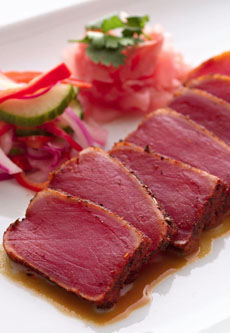TIP OF THE DAY: Choose Sustainable Seafood
|
We were away last week on Earth Day and missed publishing this piece on sustainable seafood. But it’s important to be conscious of it every day of the year.
Earth Day, initiated on April 22, 1970 and celebrated annually, is widely credited with launching the modern environmental movement. The passage of the landmark Clean Air Act, Clean Water Act, Endangered Species Act and many other groundbreaking environmental laws soon followed. There are many things each of us can do to “save the planet” and its precious resources. Today, we’ll raise some awareness about your seafood choices. The Food and Agriculture Organization of the United Nations reports that 80% of the world’s fisheries are fully exploited, with the stock overfished, depleted or recovering from depletion. With seafood growing in demand, it’s critical to get on board to reverse this trend and build a more responsible seafood supply chain. You can do your part by purchasing sustainable seafood, both for home consumption and at restaurants. Here’s your best resource for understanding what’s sustainable: |
|
|
|
The Monterey Bay Aquarium’s Seafood Watch program works to transform the seafood market in ways that support ocean-friendly fishing and fish-farming operations. Seafood Watch provides science-based seafood recommendations through its website, pocket guides and phone apps to consumers, chefs and wholesale seafood buyers. Take a minute to download the app or a printable pocket guide, or simply check out your seafood of choice on the website. Some retailers and restaurateurs act sustainably, by offering only sustainable choices and/or displaying the color-coded sustainability ratings. Whole Foods, for example, does both and no longer carries red-rated species. Other retailers and restaurants give consumers what they want, regardless of how it impacts the environment or the future of the species. For the most part, it’s up to you to ask or look it up. FOLLOW THE RATINGS There are independent, nonprofit organizations (see below)that constantly monitor the species and rate them as to sustainability. What is sustainable changes on an ongoing basis, due to the wax and wane of the seafood stock and environmental conditions. These ratings apply to both wild-caught and farmed fish: |
||
 Seared ahi (yellowfin) tuna is extremely popular. That’s one reason why it’s overfished and on the “avoid” list. Photo courtesy Ruth’s Chris Steak House. |
|
|
|
|
||



